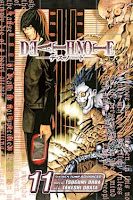 Author: Tsugumi Ohba
Author: Tsugumi Ohba
Illustrator: Takeshi Obata
U.S. publisher: Viz Media
ISBN: 9781421511788
Released: May 2007
Original release: 2006
Kindred Spirit is the eleventh and penultimate volume in the immensely popular and successful manga series Death Note, written by Tsugumi Ohba and illustrated by Takeshi Obata. Death Note has developed into quite a franchise with multiple anime adaptations, games, live-action films, novels, and merchandising in addition to the original manga series. Kindred Spirit was first released in Japan in 2006. The English-language edition from Viz Media was initially published a year later in 2007, but it is also included in the sixth and final omnibus edition of the series, released in 2011. For the most part I have been enjoying the Death Note manga (I haven’t pursued the series in any of its other incarnations), so it was about time I got around to reading Kindred Spirit.
As Light comes closer to bringing the world under his control as the god-like Kira, Near draws closer to exposing Light and his schemes. Near is already convinced that Light is Kira and that he is also posing as L, who is leading the Japanese task force responsible for investigating Kira. All Near now needs is some actual proof that ties Light, Kira, and L together. Light is well aware of Near’s efforts to capture him and that he must be more careful than ever executing his plans. Because of Near’s inquiries, several members of the task force are once again beginning to suspect Light and his motives. Because of this Light is currently unable to directly act as Kira, but he is still a skillful manipulator; there are others he can maneuver into carry out his will. Even so, there will always be some things that are outside of his control.
While some of the previous volumes of Death Note had a nice balance between action and the more cerebral aspects of the series, Kindred Spirit is almost all plotting, planning, and analysis on the characters’ parts. As a result, Kindred Spirit is very text heavy. The internal dialogues overwhelm what little external action is going on. Obata seems to be running out of ways to make the tremendous amounts of thinking that occurs in Death Note visually interesting. The most engaging and dynamic sequence in Kindred Spirits is an all too brief eight pages that has absolutely no narration or dialogue at all. Frankly, it was a welcome break. Despite the fact that the series is quickly approaching its conclusion, the preponderance of text makes it feel sluggish and not much actually happens in this volume. Still, there is some important setup for Death Note‘s finale.
Both Near and Light put complicated plans into motion in Kindred Spirit, each trying to out-think and out-maneuver the other. What was once a battle between right and wrong, and to some extent good and evil, has now simply become a battle of wits and even more so a battle of pride. Unfortunately, I found those particular battles to be much less compelling. Light seems to have lost sight of his original intent and purpose of making the world a better place, granted in ethically complicated and questionable ways. His conflict with Near in Kindred Spirit has become a game rather than a moral calling. I personally found that to be a disappointing development, but it does go to show how out of touch with reality Light has become that he can be distracted like this. I am very curious to see how things will play out in the final volume of Death Note, Finis.

Speak Your Mind